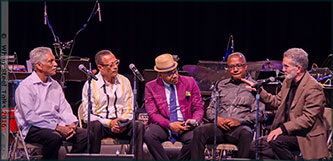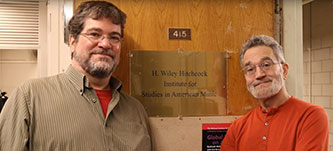American Music Review
Vol. L, Issue 2, Spring 2021
By Jeffrey Taylor
I hope Ray will forgive the silliness of the title, but we all felt a typically chilly academic announcement was insufficient for our dynamic colleague. Ray was one of the first people I met at Brooklyn College in fall of 1993, a term I remember vividly, despite being now rather aghast at the time that has passed. The Institute’s founder, H. Wiley Hitchcock, had just retired and the Institute was now in the expert hands of his student and mentee, Carol J. Oja. Ray had already spent a term as a research associate for the (then) I.S.A.M. and he knew the lay of the land much better than I. It would be some time before I moved my office permanently into the Institute’s mini-suite of rooms, but I felt a part of the enterprise immediately (indeed, it was a main reason for my accepting the job at Brooklyn). Ray and I could hardly have known we were starting a friendship and professional relationship that would last twenty-eight years.
Ray is the longest serving associate of what is now HISAM. In addition to co-editing the I.S.A.M. Newsletter/American Music Review, he worked with directors Oja, Ellie Hisama, and myself to produce conferences on a variety of subjects including Caribbean jazz, calypso music in New York, folk music icons Alan Lomax and Woody Guthrie, Brooklyn’s Black music renaissance, and genre-bending composers Henry Cowell, George Gershwin, and Ruth Crawford Seeger. Two of those conferences turned into edited volumes: Island Sounds in the Global City: Caribbean Popular Music in New York (co-edited by Ray and Lois Wilcken, University of Illinois Press, 2001), and Ruth Crawford Seeger’s Worlds: Exploring Innovation and Tradition in Twentieth Century American Music (co-edited by Ray and Ellie Hisama, University of Rochester Press, 2006). He also enjoyed a stint as Acting Director of the Institute himself. In more recent years we both worked to develop the M.M. in Global and Contemporary Jazz Program, which inspired academic conferences as well as concerts by jazz artists from Puerto Rico, the West Indies, Haiti, Israel, and India.
In addition to his work with HISAM, Ray directed the American Studies Program at Brooklyn College for more than a decade, and he developed a number of new courses as part of the Conservatory’s expanding coverage of American music. Alongside his HISAM activities and a heavy teaching load, he pursued his own research interests in New York City music cultures. In 2001 he co-compiled (and wrote the liner notes for) New York City: Global Beat of the Boroughs, a rich recording collection issued by Smithsonian Folkways that I use in class to this day. He published two monographs, Gone to the Country: The New Lost City Ramblers and the Folk Music Revival (University of Illinois Press, 2010) and Jump Up! Caribbean Carnival Music in New York City (Oxford University Press, 2019) and is currently at work on a third, a co-autobiography with St. Vincent pianist and calypso/soca arranger Frankie McIntosh. Along the way there were many journal articles and contributions to this publication.
On a personal note, Ray was one of the best editors I ever had, quick to pick up on annoying mannerisms in my prose, including my infatuation with superlatives (“Amazing!” “Stunning!” “Exquisite!”). The tight focus and elegance of the pieces in our journal are largely a result of his keen eye. One could not ask for a more generous colleague and friend. But perhaps most importantly, his inventive ideas, tenacious spirit, and endless enthusiasm (yes, here I go with the superlatives) are responsible in large part for the fact that this Institute is thriving in its fiftieth year. We’re all delighted he will stay on as a member of our Advisory Board, but his daily presence at the College will be sorely missed.








